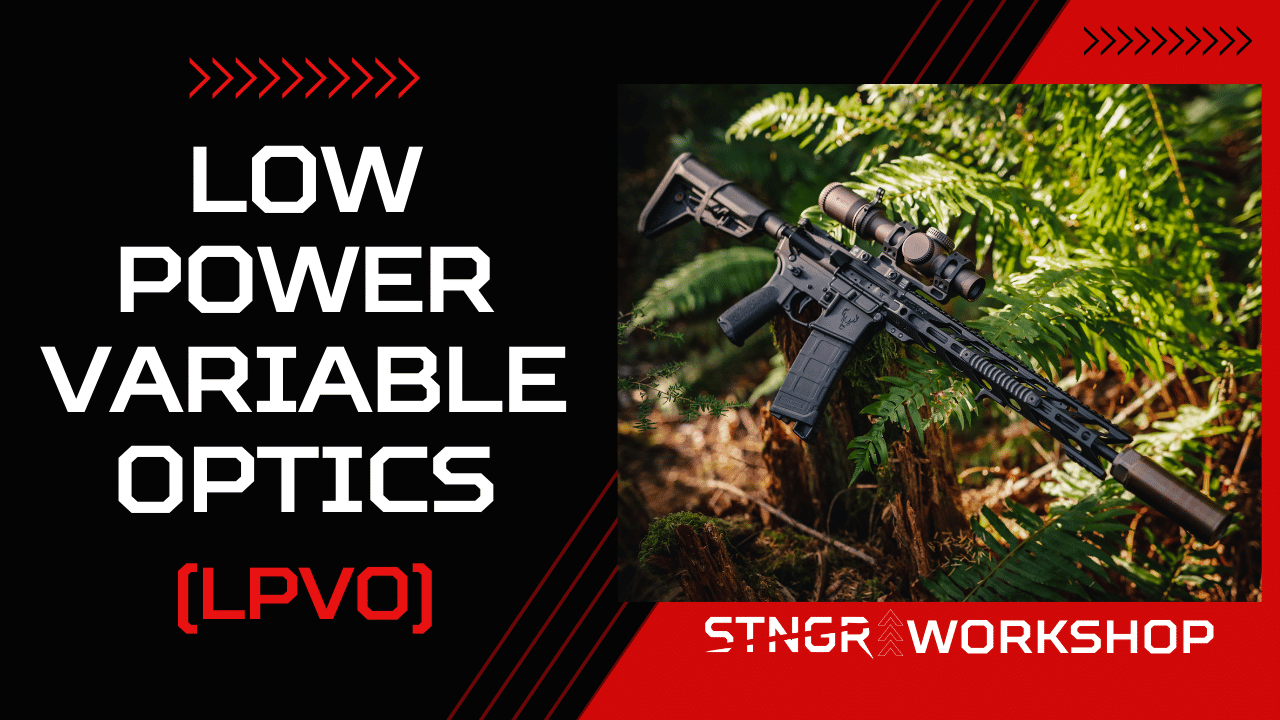What is a Low Power Variable Optic (LPVO)?
Posted by STNGR USA on Oct 13th 2022
What is a low power variable optic? Let's find out.
Hello and welcome to the STNGR Workshop. My name is Rick Barrett and I'm your host for these series of videos where we talk about everything in the gun community from gun accessories to gun maintenance.
In this video, we're gonna be talking about the major competitor to the red dot optic, the low power variable optic or LPVO for short.
Table Of Contents
Click on one of the links below to jump to a specific topic in the article.
The Low Power Variable Optic
Before we get into low power variable optics, let me first address quickly why we're not talking about traditional scopes. Now we already did a video talking about red dots versus scopes and I think that encompasses what the traditional scope does.
But when you're looking for a 1-to-1 comparison, they just don't do the same thing. Red dot optics can perform a variety of functions, self defense and plinking among them. This is in contrast to traditional scopes, which have one purpose which is hunting (in particular big game hunting) and we discuss this in the red dot versus scope video.
But to give you a real apples-to-apples comparison, low power variable optics are more of a direct competition to red dot optics, which is why we're going to focus on those for the remainder of this video.
What is a Low Power Variable Optic?
LPVOs have exploded in popularity recently. Their design and magnification settings allow LPVOs to be a versatile option for many different types of long guns.
Now, just to be clear when I talk about long guns, I'm talking about AR-15s, pistol caliber carbines, and personal defense weapons. Shotguns are a totally different topic for a totally different day.
LPVOs typically have a very distinct look with a large ocular lens and eyepiece, and a narrow objective lens. Since the magnification range varies from 1-8x (1 to 8 power) the user can quickly swap magnification settings to better accomplish their mission, whether that is self-defense or 3-Gun Competition. Many companies making LPVOs, such as the Vortex Optics Strike Eagle, didn't focus on making the magnification super powerful but rather found the balance between good magnification and solid eye relief.
Pros of the LPVO
If there was one selling point to LPVOs, it's the eye relief.
Now we talked about eye relief in our red dot video, but as a quick refresher eye relief is the distance between the lens of the binocular or scope to the tip of your eye. When you're viewing a scene through any lens with incorrect eye relief distance, that picture you see will be distorted either with a funny image or with a black ring around the field of view.
When your rifle scope is mounted with accurate eye relief, your field of view through that scope should be bright and full. In fact, it was the reason that the low power variable optics or the LPVOs were created as a go-between between red dot optics and full-blown scopes.
Rifle Scope Eye Relief. Image from Desert Tech.
Cons of the LPVO
So the LPVO is kind of like a compromise between a red dot optic and a full-blown scope. On the one hand, it's gonna give you good eye relief and fast target acquisition that you would get with a red dot while giving you the magnification of a full-blown scope.
Now, as great as they sound, LPVOs do have one major downside and that is the size and the weight of your typical LPVO. While LPVOs are really good, they're just not better than red dot optics, which is why red dot optics are still around.
Why Use a Low Power Variable Optic?
If you're somebody who wants to do close-up, fast action shooting and you also want the ability to hit targets at mid ranges between 500 to 800 yards, the LPVO is a great option for you. If you were looking for a self-defense optic, red dots would be a better choice for that situation.
Final Thoughts
And that's it for this video. Coming to you from the STNGR Workshop, my name is Rick Barrett. I hope you enjoyed this video and I'll talk to you again soon.


